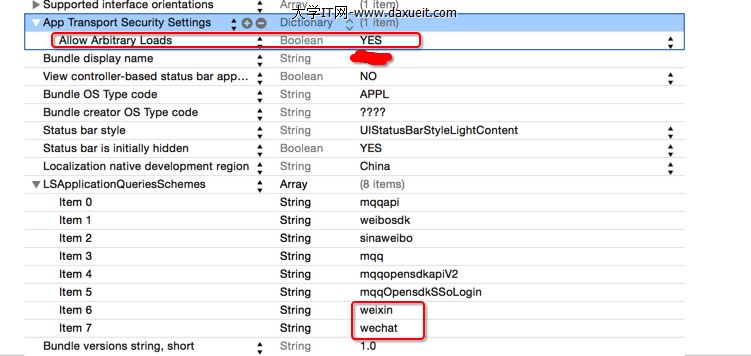NSPredicate簡單介紹
NSPredicate中主要的幾種運算方式
1.比較運算符 > 、< 、== 、 >= 、<= 、 !=
例:@"number >= 99"
2.邏輯運算符:AND、OR、NOT 這幾個運算符計算並、或、非的結果。
3.范圍運算符:IN 、BETWEEN
例:@"number BETWEEN {1,5}"
@"address IN {'shanghai','nanjing'}"
4.字符串本身:SELF
例:@"SELF == 'APPLE'"
5.字符串相關:BEGINSWITH、ENDSWITH、CONTAINS
例: @"name CONTAIN[cd] 'ang'" //包含某個字符串
@"name BEGINSWITH[c] 'sh'" //以某個字符串開頭
@"name ENDSWITH[d] 'ang'" //以某個字符串結束
注:[c]不區分大小寫 , [d]不區分發音符號即沒有重音符號 , [cd]既不區分大小寫,也不區分發音符號。
6.通配符:LIKE
例:@"name LIKE[cd] '*er*'" //*代表通配符,Like也接受[cd].
@"name LIKE[cd] '???er*'"
7.正則表達式:MATCHES
例:NSString *regex = @"^A.+e$"; //以A開頭,e結尾
@"name MATCHES %@",regex
用NSPredicate篩選兩個數組的差異
NSArray* array = @[@"aa",@"bb"];
NSArray* array2 = @[@"aa",@"bb",@"cc",@"dd"];
NSPredicate* thePredicate = [NSPredicate predicateWithFormat:@"NOT(SELF in %@)",array];
NSArray* arr3 = [array2 filteredArrayUsingPredicate:thePredicate];
NSLog(@"%@",arr3);
上面的代碼輸出結果 arr3={@"cc" ,@"dd"}
用NSPredicate篩選數組
NSString *regex = @"^A.+e$";//以A 開頭,以e 結尾的字符。
NSPredicate *pre= [NSPredicate predicateWithFormat:@"SELF MATCHES %@", regex];
if([pre evaluateWithObject: @"Apple"]){NSLog(@"YES");
}else{NSLog(@"NO");
}
關於NSPredicate的其他說明和注意事項,以及技巧
動態屬性名
NSPredicate *p = [NSPredicate predicateWithFormat:@"name = %@", @"name1"];
顯然代碼沒有任何問題,但是這個不是最好的寫法我建議如下寫法:
NSPredicate *preTemplate = [NSPredicate predicateWithFormat:@"name==$NAME"];
NSDictionary *dic=[NSDictionary dictionaryWithObjectsAndKeys:
@"name1", @"NAME",nil];
NSPredicate *pre=[preTemplate predicateWithSubstitutionVariables: dic];
這樣看上去可能會讓代碼邏輯更清晰。
當過濾條件字段都是動態的時候
NSString *key = @"name";
NSString *value = @"name1";
NSPredicate *p = [NSPredicate predicateWithFormat:@"%@ = %@", key, value];然後當你執行到第三行的時候代碼就會報錯!
邏輯上沒錯誤啊!!!為什麼會出錯呢?
NSPredicate要自動添加引號,所以最後得到的格式應該是@"'name' = 'name1'"。明顯不對。要做的就是:
NSPredicate *p = [NSPredicate predicateWithFormat:@"%K = %@", key, value];
- 上一頁:NSUserDefaults 、對象歸檔
- 下一頁:多線程的簡單使用
- IOS 開辟自界說條形ProgressView的實例
- iOS10語音辨認框架SpeechFramework運用詳解
- iOS10 App適配權限 Push Notifications 字體Frame 碰到的成績
- iOS開辟之(APNS)長途推送完成代碼 附證書與真機調試
- IOS 波紋進度(waveProgress)動畫完成
- iOS中NSArray數組經常使用處置方法
- iOS基本常識之@property 和 Ivar 的差別
- iOS 9 Core Spotlight搜刮實例代碼
- iOS中應用JSPatch框架使Objective-C與JavaScript代碼交互
- iOS中應用NSURLConnection處置HTTP同步與異步要求
- 實例講授iOS中的CATransition轉場動畫應用
- iOS中的表單按鈕選項UIActionSheet經常使用辦法整頓
- iOS多線程開辟——NSThread淺析
- iOS運用開辟中應用NSLocale類完成對象信息的當地化
- iOS中的NSTimer准時器的初步應用解析
- 蘋果iPhoneSE怎麼刷新App Store?
- 使用iPhone拍攝出單反感覺照片的方法
- iphone5s、5c、6p中的s、c、p含義是什麼?
- iPhone如何恢復固件(DFU模式)?iPhone恢復固件(DFU模式)的常見方
- iPhone6s低溫自動關機怎麼回事 iPhone6s冬天自動關機解決方法
- iOS7照片流在哪 iOS7照片流分享功能圖文解說
- iOS9越獄Cydia閃退怎麼辦 iOS9越獄Cydia閃退的解決方法
- Apple Watch的功能有哪些?Apple Watch入門教程
- iOS9.1/9.2/9.2.1微信BUG測試 快捷回復信息鍵盤卡住
- iPhone6s天氣怎麼添加刪除城市?iPhone6s天氣添加刪除城市教程




